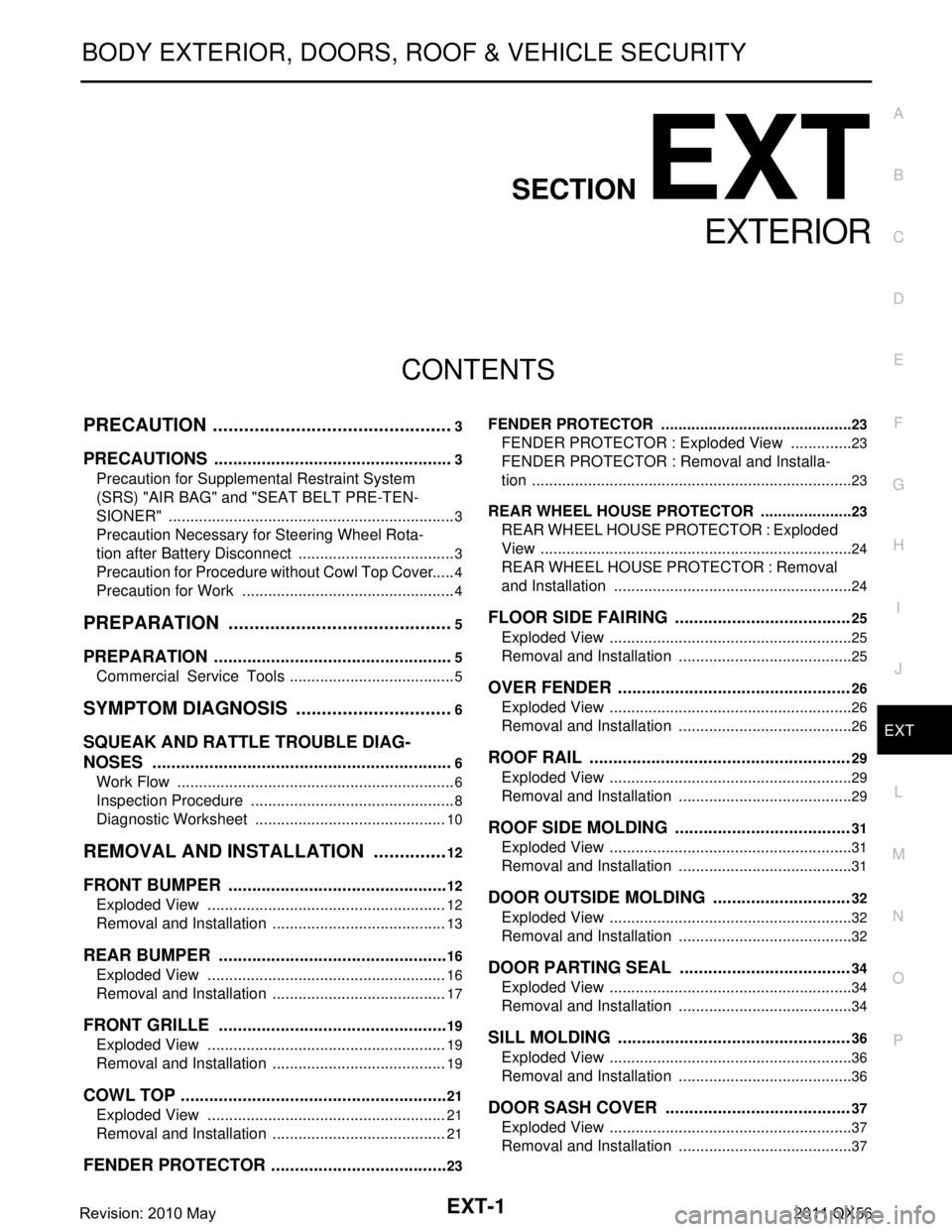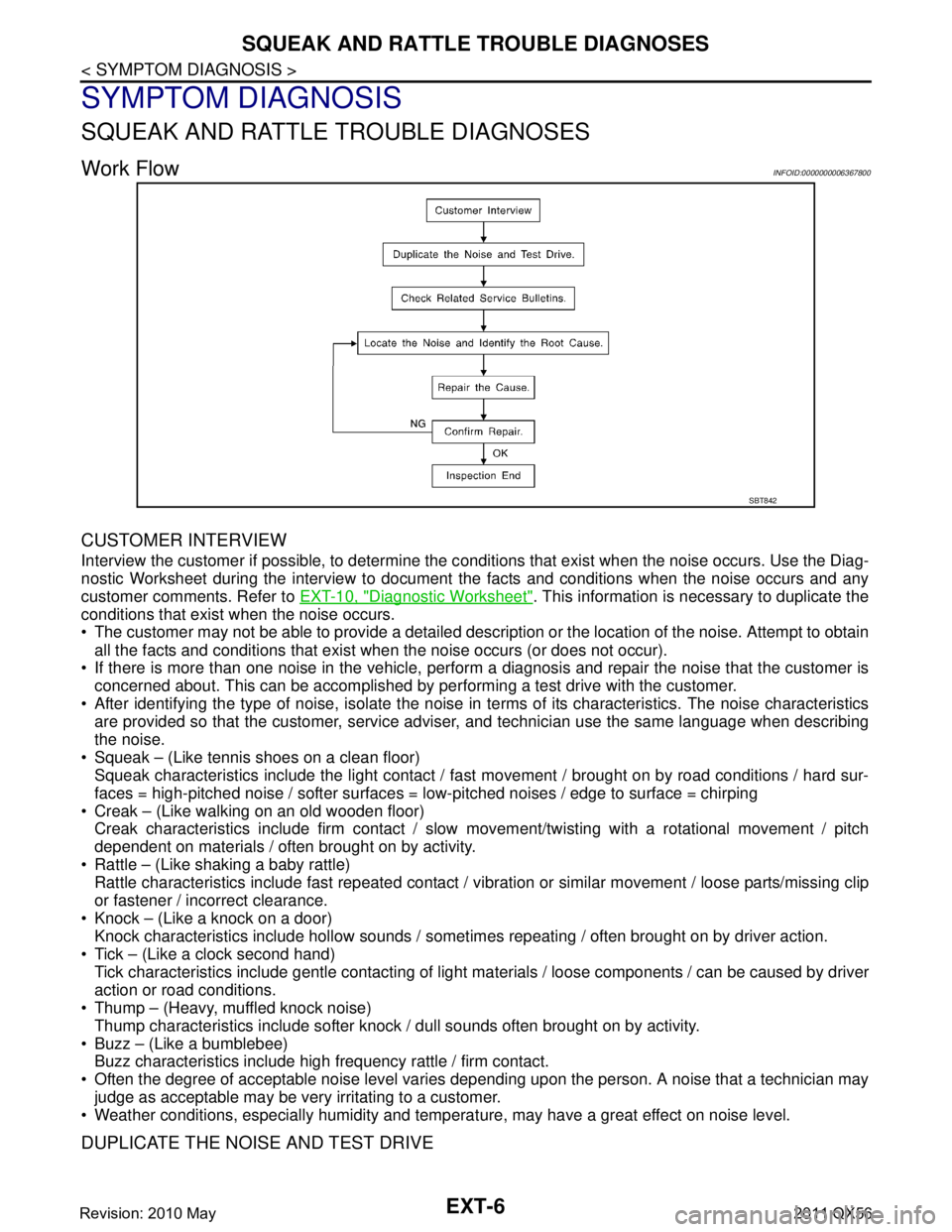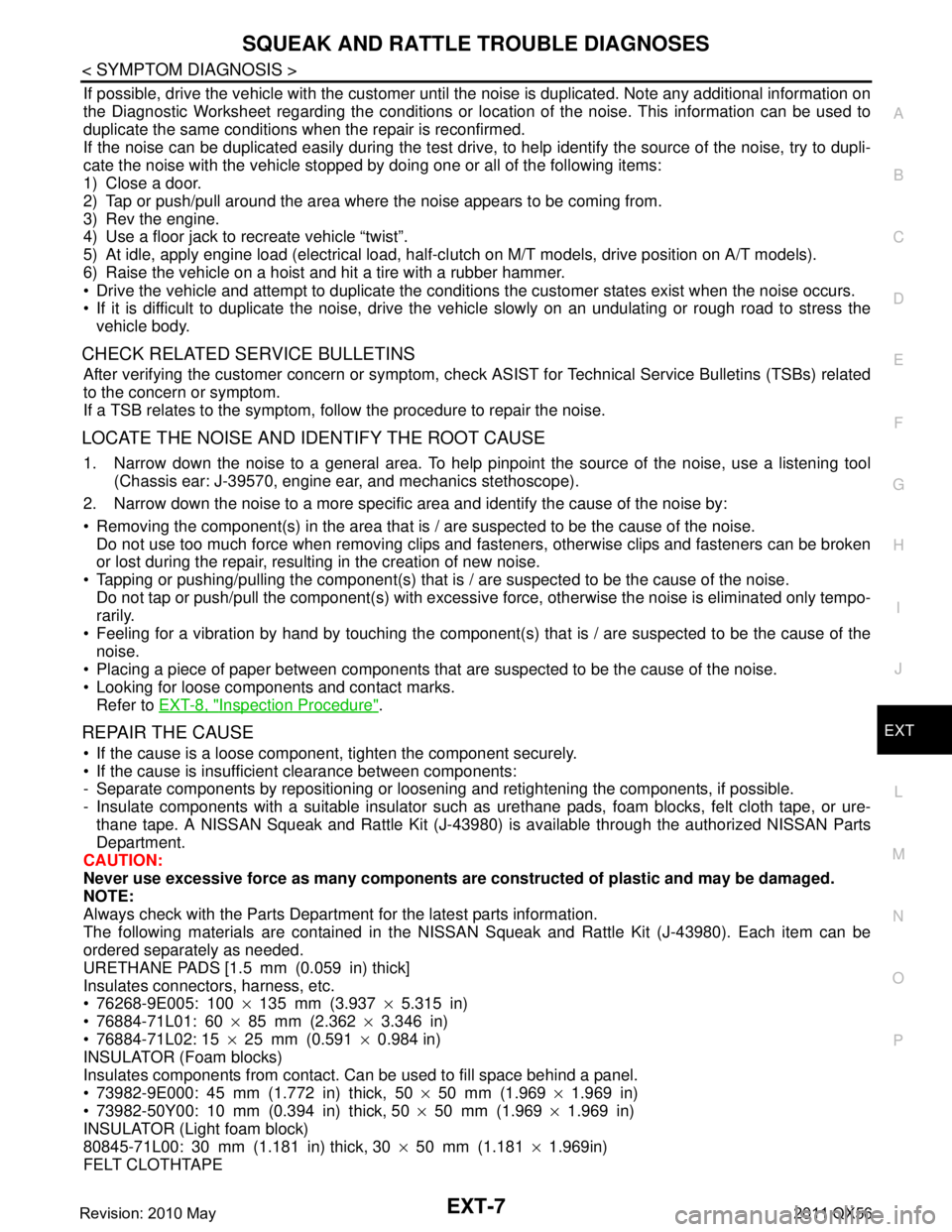2011 INFINITI QX56 door
[x] Cancel search: doorPage 2821 of 5598
![INFINITI QX56 2011 Factory Service Manual
TAIL LAMP CIRCUITEXL-111
< DTC/CIRCUIT DIAGNOSIS > [XENON TYPE]
C
D
E
F
G H
I
J
K
M A
B
EXL
N
O P
Is the inspection result normal?
YES >> Tail lamp (back door side) circuit is normal.
NO >> Refer to INFINITI QX56 2011 Factory Service Manual
TAIL LAMP CIRCUITEXL-111
< DTC/CIRCUIT DIAGNOSIS > [XENON TYPE]
C
D
E
F
G H
I
J
K
M A
B
EXL
N
O P
Is the inspection result normal?
YES >> Tail lamp (back door side) circuit is normal.
NO >> Refer to](/manual-img/42/57033/w960_57033-2820.png)
TAIL LAMP CIRCUITEXL-111
< DTC/CIRCUIT DIAGNOSIS > [XENON TYPE]
C
D
E
F
G H
I
J
K
M A
B
EXL
N
O P
Is the inspection result normal?
YES >> Tail lamp (back door side) circuit is normal.
NO >> Refer to E X L - 111 , "
BACK DOOR SIDE : Diagnosis Procedure".
BACK DOOR SIDE : Diagnosis ProcedureINFOID:0000000006238403
1.CHECK TAIL LAMP (BACK DOOR SIDE) BULB
Check the applicable lamp bulb.
Is the inspection result normal?
YES >> GO TO 2.
NO >> Replace bulb.
2.CHECK TAIL LAMP (BACK DOOR SIDE) OPEN CIRCUIT
1. Turn ignition switch OFF.
2. Disconnect IPDM E/R connector and tail lamp (back door side) connector.
3. Check continuity between IPDM E/R harness connec tor and tail lamp (back door side) harness connector.
Is the inspection result normal?
YES >> GO TO 3.
NO >> Repair or replace harness.
3.CHECK TAIL LAMP (BACK DOOR SIDE) GROUND OPEN CIRCUIT
Check continuity between tail lamp (back door side) harness connector and ground.
Is the inspection result normal?
YES >> Check corresponding bulb socket and harness. Repair or replace if necessary.
NO >> Repair or replace harness. TAIL : Tail lamp (back door side) ON
Off : Tail lamp (back door side) OFF
IPDM E/R Tail lamp (back door side)
Continuity
Connector Terminal Connector Terminal
LH E14 44 D169
1 Existed
RH D117
Tail lamp (back door side)
GroundContinuity
Connector Terminal
LH D169 2Existed
RH D117
Revision: 2010 May2011 QX56
Page 2824 of 5598
![INFINITI QX56 2011 Factory Service Manual
EXL-114
< SYMPTOM DIAGNOSIS >[XENON TYPE]
EXTERIOR LIGHTING SYSTEM SYMPTOMS
Each lamp is not turned ON/OFF with lighting switch
AUTO. Combination switch
Harness between combination
switch and BC INFINITI QX56 2011 Factory Service Manual
EXL-114
< SYMPTOM DIAGNOSIS >[XENON TYPE]
EXTERIOR LIGHTING SYSTEM SYMPTOMS
Each lamp is not turned ON/OFF with lighting switch
AUTO. Combination switch
Harness between combination
switch and BC](/manual-img/42/57033/w960_57033-2823.png)
EXL-114
< SYMPTOM DIAGNOSIS >[XENON TYPE]
EXTERIOR LIGHTING SYSTEM SYMPTOMS
Each lamp is not turned ON/OFF with lighting switch
AUTO. Combination switch
Harness between combination
switch and BCM
BCM Combination switch
Refer to
BCS-80, "
Symptom Table".
Optical sensor
Harness between optical sen- sor and BCM
BCM Optical sensor
Refer to
EXL-102, "
Component
Function Check".
Front fog lamp is not
turned ON. One side
Front fog lamp bulb
Harness between IPDM E/R
and front fog lamp
Front fog lamp
IPDM E/R Front fog lamp circuit
Refer to
EXL-94, "
Component
Function Check".
Both sides Symptom diagnosis
“BOTH SIDE FRONT FOG LAMPS ARE NOT TURNED ON”
Refer to
EXL-120, "
Diagnosis Procedure".
Parking lamp is not turned ON. Parking lamp bulb
Harness between IPDM E/R
and front combination lamp
Front combination lamp
IPDM E/R Parking lamp
circuit
Refer to EXL-96, "
Component
Function Check".
Front side marker lamp is not turned ON. Front side marker lamp bulb
Harness between IPDM E/R
and front combination lamp
Front combination lamp
IPDM E/R Front side marker lamp circuit
Refer to
EXL-98, "
Component
Function Check".
Tail lamp or rear side
marker lamp is not turned
ON. Body side
Harness between IPDM E/R
and rear combination lamp
Rear combination lamp Tail lamp circuit (body side)
Refer to
EXL-109, "
BODY SIDE :
Component Function Check".
Back door side Harness between IPDM E/R
and tail lamp (back door side)
Tail lamp (back door side) Tail lamp circuit (back door side)
Refer to
EXL-110, "
BACK DOOR
SIDE : Component Function
Check".
License plate lamp is not turned ON. License plate lamp bulb
Harness between IPDM E/R
and license plate lamp
License plate lamp License plate lamp circuit
Refer to
EXL-112, "
Component
Function Check".
Tail lamp, rear side marker lamp and license plate
lamp are not turned ON. Fuse
Harness between IPDM E/R
and rear combination lamp (LH)
IPDM E/R Tail lamp circuit (body side)
Refer to
EXL-109, "
BODY SIDE :
Component Function Check".
Parking lamp, side marker lamp, tail lamp and li- cense plate lamp are not turned ON.
Parking lamp, side marker lamp, tail lamp and li- cense plate lamp are not turned OFF.
(Each illumination is turned ON/OFF.) Symptom diagnosis
“PARKING, LICENSE PLATE, SIDE MARKER LAMP AND TAIL LAMPS
ARE NOT TURNED ON”
Refer to
EXL-119, "
Diagnosis Procedure".
Tail lamp indicator is not turned ON.
(Parking, side marker lamp and tail lamps are turned
ON.) Combination meter Combination meter
Data monitor “LIGHT IND”
BCM (HEAD LAMP) Active test “TAIL LAMP”
Turn signal lamp does not
blink. Indicator lamp is nor-
mal.
(Applicable side per-
forms the high flasher
activation.)
Harness between BCM and
each turn signal lamp
Turn signal lamp bulb Turn signal lamp circuit
Refer to
EXL-99, "
Component
Function Check".
Indicator lamp is includ-
ed. Combination switch
Harness between combination
switch and BCM
BCM Combination switch
Refer to
BCS-80, "
Symptom Table".
Symptom Possible cause Inspection item
Revision: 2010 May2011 QX56
Page 2840 of 5598
![INFINITI QX56 2011 Factory Service Manual
EXL-130
< REMOVAL AND INSTALLATION >[XENON TYPE]
SIDE TURN SIGNAL LAMP
SIDE TURN SIGNAL LAMP
Exploded ViewINFOID:0000000006369470
Removal and InstallationINFOID:0000000006369471
CAUTION:
Disconnect b INFINITI QX56 2011 Factory Service Manual
EXL-130
< REMOVAL AND INSTALLATION >[XENON TYPE]
SIDE TURN SIGNAL LAMP
SIDE TURN SIGNAL LAMP
Exploded ViewINFOID:0000000006369470
Removal and InstallationINFOID:0000000006369471
CAUTION:
Disconnect b](/manual-img/42/57033/w960_57033-2839.png)
EXL-130
< REMOVAL AND INSTALLATION >[XENON TYPE]
SIDE TURN SIGNAL LAMP
SIDE TURN SIGNAL LAMP
Exploded ViewINFOID:0000000006369470
Removal and InstallationINFOID:0000000006369471
CAUTION:
Disconnect battery negative terminal or remove the fuse.
REMOVAL
1. Remove the door mirror. Refer to
MIR-32, "DOOR MIRROR ASSEMBLY : Removal and Installation".
2. Remove the door mirror glass. Refer to MIR-35, "
GLASS MIRROR : Removal and Installation".
3. Remove the side camera finisher. Refer to MIR-33, "
DOOR MIRROR ASSEMBLY : Disassembly and
Assembly".
4. Remove side turn signal lamp fixing screws (E), and then remove side turn signal lamp (with side turn signal lamp models
only).
NOTE:
Pull slightly side camera finisher (1) covering side turn signal
lamp bottom screw.
INSTALLATION
Install in the reverse order of removal.
1. Door mirror assembly 2. Door mi rror cover 3. Side camera finisher
4. Side turn signal lamp housing 5. Side turn signal lamp bulb
JMLIA1110ZZ
JMLIA0914ZZ
Revision: 2010 May2011 QX56
Page 2853 of 5598
![INFINITI QX56 2011 Factory Service Manual
LICENSE PLATE LAMPEXL-143
< REMOVAL AND INSTALLATION > [XENON TYPE]
C
D
E
F
G H
I
J
K
M A
B
EXL
N
O P
LICENSE PLATE LAMP
Exploded ViewINFOID:0000000006369489
Removal and InstallationINFOID:0000000006 INFINITI QX56 2011 Factory Service Manual
LICENSE PLATE LAMPEXL-143
< REMOVAL AND INSTALLATION > [XENON TYPE]
C
D
E
F
G H
I
J
K
M A
B
EXL
N
O P
LICENSE PLATE LAMP
Exploded ViewINFOID:0000000006369489
Removal and InstallationINFOID:0000000006](/manual-img/42/57033/w960_57033-2852.png)
LICENSE PLATE LAMPEXL-143
< REMOVAL AND INSTALLATION > [XENON TYPE]
C
D
E
F
G H
I
J
K
M A
B
EXL
N
O P
LICENSE PLATE LAMP
Exploded ViewINFOID:0000000006369489
Removal and InstallationINFOID:0000000006369490
CAUTION:
Disconnect the battery negative terminal or remove the fuse.
REMOVAL
1. Remove back door trim. Refer to INT-39, "Removal and Installation".
2. Disconnect license plate lamp connector.
3. Remove back door finisher center upper.
4. Remove license plate lamp while pushing a resin clip, and then remove license plate lamp.
INSTALLATION
Install in the reverse order of removal.
ReplacementINFOID:0000000006369491
CAUTION:
Disconnect the battery negative terminal or remove the fuse.
Never touch the glass of bulb directly by hand. Keep grease and other oily matters away from it.
Never touch bulb by hand while it is lit or right after being turned off.
Never leave bulb out of lamp reflector for a long time because dust, moisture smoke, etc. may affect
the performance of lamp. When replacing bu lb, be sure to replace it with new one.
LICENSE PLATE LAMP BULB
1. Remove back door trim. Refer to INT-39, "Removal and Installation".
2. Disconnect license plate lamp connector.
1. License plate lamp harness 2. License plate lamp bulb socket 3. License plate lamp bulb
4. License plate lamp 5. Back door finisher center upper
JMLIA1122ZZ
Revision: 2010 May2011 QX56
Page 2856 of 5598

EXT-1
BODY EXTERIOR, DOORS, ROOF & VEHICLE SECURITY
C
D
E
F
G H
I
J
L
M
SECTION EXT
A
B
EXT
N
O P
CONTENTS
EXTERIOR
PRECAUTION ................ ...............................3
PRECAUTIONS .............................................. .....3
Precaution for Supplemental Restraint System
(SRS) "AIR BAG" and "SEAT BELT PRE-TEN-
SIONER" ............................................................. ......
3
Precaution Necessary for Steering Wheel Rota-
tion after Battery Disconnect .....................................
3
Precaution for Procedure without Cowl Top Cover ......4
Precaution for Work ..................................................4
PREPARATION ............................................5
PREPARATION .............................................. .....5
Commercial Service Tools ................................. ......5
SYMPTOM DIAGNOSIS ...............................6
SQUEAK AND RATTLE TROUBLE DIAG-
NOSES ........................ ........................................
6
Work Flow ........................................................... ......6
Inspection Procedure ................................................8
Diagnostic Worksheet .............................................10
REMOVAL AND INSTALLATION ...............12
FRONT BUMPER ........................................... ....12
Exploded View .................................................... ....12
Removal and Installation .........................................13
REAR BUMPER .................................................16
Exploded View .................................................... ....16
Removal and Installation .........................................17
FRONT GRILLE .................................................19
Exploded View .................................................... ....19
Removal and Installation .........................................19
COWL TOP .........................................................21
Exploded View .................................................... ....21
Removal and Installation .........................................21
FENDER PROTECTOR ......................................23
FENDER PROTECTOR ......................................... ....23
FENDER PROTECTOR : Exploded View ...............23
FENDER PROTECTOR : Removal and Installa-
tion ...........................................................................
23
REAR WHEEL HOUSE PROTECTOR .................. ....23
REAR WHEEL HOUSE PROTECTOR : Exploded
View .........................................................................
24
REAR WHEEL HOUSE PROTECTOR : Removal
and Installation ........................................................
24
FLOOR SIDE FAIRING .....................................25
Exploded View .........................................................25
Removal and Installation .........................................25
OVER FENDER .................................................26
Exploded View .........................................................26
Removal and Installation .........................................26
ROOF RAIL .......................................................29
Exploded View .........................................................29
Removal and Installation .........................................29
ROOF SIDE MOLDING .....................................31
Exploded View .........................................................31
Removal and Installation .........................................31
DOOR OUTSIDE MOLDING .............................32
Exploded View .........................................................32
Removal and Installation .........................................32
DOOR PARTING SEAL ....................................34
Exploded View .........................................................34
Removal and Installation .........................................34
SILL MOLDING .................................................36
Exploded View .........................................................36
Removal and Installation .........................................36
DOOR SASH COVER .......................................37
Exploded View .........................................................37
Removal and Installation .........................................37
Revision: 2010 May2011 QX56
Page 2857 of 5598

EXT-2
FRONT PILLAR FINISHER ...............................40
Exploded View ..................................................... ...40
Removal and Installation ........................................40
REAR SPOILER ................................................41
Exploded View ..................................................... ...41
Removal and Installation ........................................41
DRIP MOLDING .................................................43
Exploded View ..................................................... ...43
Removal and Installation ...................................... ...43
BACK DOOR FINISHER ...................................44
Exploded View ..................................................... ...44
Removal and Installation .........................................44
SIDE STEP ........................................................45
Exploded View ..................................................... ...45
Removal and Installation .........................................45
Revision: 2010 May2011 QX56
Page 2861 of 5598

EXT-6
< SYMPTOM DIAGNOSIS >
SQUEAK AND RATTLE TROUBLE DIAGNOSES
SYMPTOM DIAGNOSIS
SQUEAK AND RATTLE TROUBLE DIAGNOSES
Work FlowINFOID:0000000006367800
CUSTOMER INTERVIEW
Interview the customer if possible, to determine the c onditions that exist when the noise occurs. Use the Diag-
nostic Worksheet during the interview to document the facts and conditions when the noise occurs and any
customer comments. Refer to EXT-10, "
Diagnostic Worksheet". This information is necessary to duplicate the
conditions that exist when the noise occurs.
The customer may not be able to provide a detailed description or the location of the noise. Attempt to obtain
all the facts and conditions that exist w hen the noise occurs (or does not occur).
If there is more than one noise in the vehicle, perform a diagnosis and repair the noise that the customer is
concerned about. This can be accomplished by per forming a test drive with the customer.
After identifying the type of noise, isolate the noise in terms of its characteristics. The noise characteristics
are provided so that the customer, service advis er, and technician use the same language when describing
the noise.
Squeak – (Like tennis shoes on a clean floor) Squeak characteristics include the light contact / fast movement / brought on by road conditions / hard sur-
faces = high-pitched noise / softer surfaces = low-pitched noises / edge to surface = chirping
Creak – (Like walking on an old wooden floor) Creak characteristics include firm contact / slow movement/twisting with a rotational movement / pitch
dependent on materials / often brought on by activity.
Rattle – (Like shaking a baby rattle) Rattle characteristics include fast repeated contact / vibr ation or similar movement / loose parts/missing clip
or fastener / incorrect clearance.
Knock – (Like a knock on a door) Knock characteristics include hollow sounds / someti mes repeating / often brought on by driver action.
Tick – (Like a clock second hand) Tick characteristics include gentle contacting of light materials / loose components / can be caused by driver
action or road conditions.
Thump – (Heavy, muffled knock noise)
Thump characteristics include softer knock / dull sounds often brought on by activity.
Buzz – (Like a bumblebee) Buzz characteristics include high frequency rattle / firm contact.
Often the degree of acceptable noise level varies depending upon the person. A noise that a technician may
judge as acceptable may be very irritating to a customer.
Weather conditions, especially humidity and temperat ure, may have a great effect on noise level.
DUPLICATE THE NOISE AND TEST DRIVE
SBT842
Revision: 2010 May2011 QX56
Page 2862 of 5598

SQUEAK AND RATTLE TROUBLE DIAGNOSESEXT-7
< SYMPTOM DIAGNOSIS >
C
DE
F
G H
I
J
L
M A
B
EXT
N
O P
If possible, drive the vehicle with the customer until the noise is duplicated. Note any additional information on
the Diagnostic Worksheet regarding the conditions or lo cation of the noise. This information can be used to
duplicate the same conditions when the repair is reconfirmed.
If the noise can be duplicated easily during the test drive, to help identify the source of the noise, try to dupli-
cate the noise with the vehicle stopped by doing one or all of the following items:
1) Close a door.
2) Tap or push/pull around the area where the noise appears to be coming from.
3) Rev the engine.
4) Use a floor jack to recreate vehicle “twist”.
5) At idle, apply engine load (electrical load, half-cl utch on M/T models, drive position on A/T models).
6) Raise the vehicle on a hoist and hit a tire with a rubber hammer.
Drive the vehicle and attempt to duplicate the conditions the customer states exist when the noise occurs.
If it is difficult to duplicate the noise, drive the vehicle slowly on an undulating or rough road to stress the
vehicle body.
CHECK RELATED SERVICE BULLETINS
After verifying the customer concern or symptom, che ck ASIST for Technical Service Bulletins (TSBs) related
to the concern or symptom.
If a TSB relates to the symptom, follow the procedure to repair the noise.
LOCATE THE NOISE AND IDENTIFY THE ROOT CAUSE
1. Narrow down the noise to a general area. To help pinpoint the source of the noise, use a listening tool
(Chassis ear: J-39570, engine ear, and mechanics stethoscope).
2. Narrow down the noise to a more specific area and identify the cause of the noise by:
Removing the component(s) in the area that is / are suspected to be the cause of the noise.
Do not use too much force when removing clips and fasteners, otherwise clips and fasteners can be broken
or lost during the repair, resulting in the creation of new noise.
Tapping or pushing/pulling the component(s) that is / are suspected to be the cause of the noise.
Do not tap or push/pull the component(s) with excessive force, otherwise the noise is eliminated only tempo-
rarily.
Feeling for a vibration by hand by touching the component(s ) that is / are suspected to be the cause of the
noise.
Placing a piece of paper between components that are suspected to be the cause of the noise.
Looking for loose components and contact marks. Refer to EXT-8, "
Inspection Procedure".
REPAIR THE CAUSE
If the cause is a loose component, tighten the component securely.
If the cause is insufficient clearance between components:
- Separate components by repositioning or loosening and retightening the components, if possible.
- Insulate components with a suitable insulator such as urethane pads, foam blocks, felt cloth tape, or ure-
thane tape. A NISSAN Squeak and Rattle Kit (J-43980) is available through the authorized NISSAN Parts
Department.
CAUTION:
Never use excessive force as many components are constructed of plastic and may be damaged.
NOTE:
Always check with the Parts Department for the latest parts information.
The following materials are contained in the NISSA N Squeak and Rattle Kit (J-43980). Each item can be
ordered separately as needed.
URETHANE PADS [1.5 mm (0.059 in) thick]
Insulates connectors, harness, etc.
76268-9E005: 100 ×135 mm (3.937 ×5.315 in)
76884-71L01: 60 ×85 mm (2.362 ×3.346 in)
76884-71L02: 15 ×25 mm (0.591 ×0.984 in)
INSULATOR (Foam blocks)
Insulates components from contact. Can be used to fill space behind a panel.
73982-9E000: 45 mm (1.772 in) thick, 50 ×50 mm (1.969 ×1.969 in)
73982-50Y00: 10 mm (0.394 in) thick, 50 ×50 mm (1.969 ×1.969 in)
INSULATOR (Light foam block)
80845-71L00: 30 mm (1.181 in) thick, 30 ×50 mm (1.181 ×1.969in)
FELT CLOTHTAPE
Revision: 2010 May2011 QX56